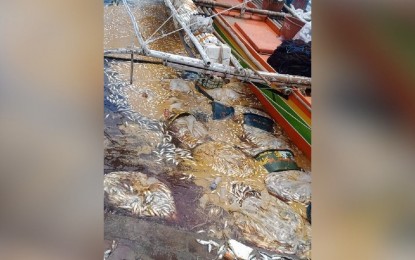
TOTAL WASTE. A fisheries official has blamed overfishing in Bicol and Samar for the rotting sardines found in the fish port of Bulan town, Sorsogon province, as shown in this Facebook post on Friday (May 28, 2021). According to the post, vendors have thrown tubs of sardines as no one was buying them even at a measly price of PHP20 per basin. (Photo from Bong Hapon)
LEGAZPI CITY – A fisheries official has blamed overfishing in Bicol and Samar for the rotting sardines found in Bulan town, Sorsogon province, photos of which have made the rounds on social media.
In an interview on Friday, Bureau of Fisheries and Aquatic Resources (BFAR) 5 (Bicol) spokesperson Nonie Enolva said some fishermen still go to sea for another round of fishing despite the oversupply of sardines, locally known as law-law or tamban, at Bulan’s fish port on any given day.
Enolva said fishermen and fish vendors throw the sardines back to the waters once these are spoiled several hours or a day after they are caught.
“If nobody wants to buy the fast-spoiling tamban even at PHP20 per (basin), the vendors decide to just throw them away or abandon them in a corner near the fish port or market,” she told the Philippine News Agency (PNA).
Enolva explained that sardines spoil faster than other fish and the sardine factory in Sorsogon buys only fresh catch.
Fresh sardines sell at PHP1,600 to PHP2,000 per barrel, which weighs up to 40 kg., she said.
Even fish buyers from the National Capital Region could not afford to buy the big volume of sardines that land at Bulan port because of their limited capacity to haul the catch back to their places, Enolva said.
“There is really (overfishing) of these tamban during its peak season that usually starts in December and ends in June or July,” she added.
Enolva noted that Bicol is the country’s second-largest producer of sardines after the Zamboanga Peninsula.
Sardines, she said, represent 15 percent of the country’s total fish production, reaching more than 333,000 metric tons a year.
Enolva said another reason for the oversupply could be that sardines caught in the waters off Samar and other areas in Eastern Visayas are brought to Sorsogon.
“I think these fishermen are landing their catch in Sorsogon rather than in their distant places of origin in order to immediately dispose of their haul before they get spoiled,” she said.
Enolva said their office is continuously coordinating with various government and non-government agencies to solve this perennial issue of rotting sardines.
The BFAR, she said, has a five-year national sardines management plan that would address challenges in developing the local sardine industry.
The plan aims to make fish stocks sustainable by reducing the catching of juvenile fish by 10 percent in five years.
Enolva said the program hopes to reduce post-harvest losses and reduce poverty through alternative livelihood programs and social enterprise.
"This will develop science-based management of sardine fisheries, data platform for production data, and stronger implementation of fisheries laws," she added. (PNA)
